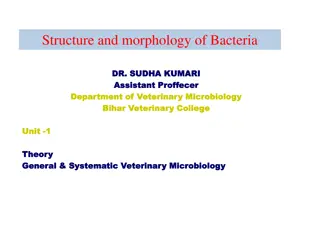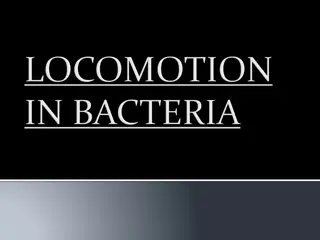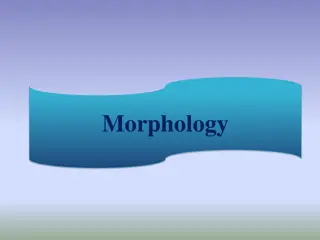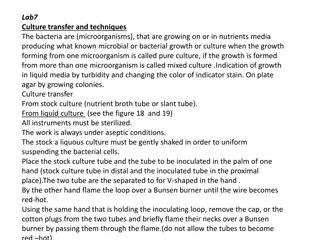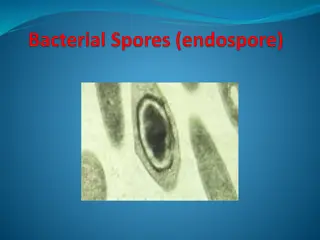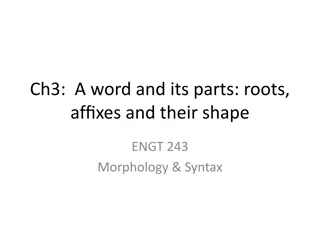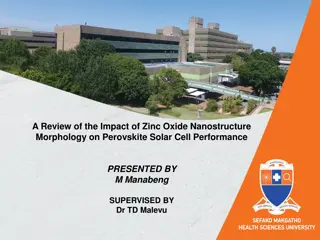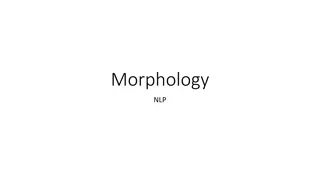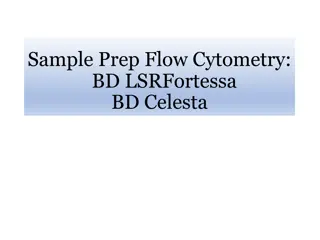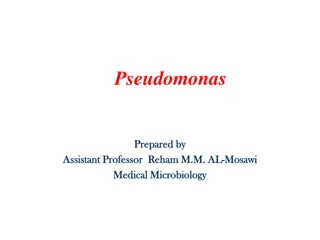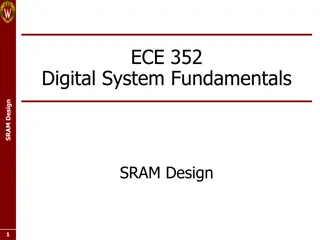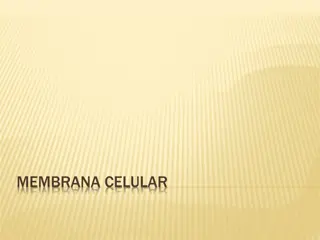Overview of Bacterial Morphology and Cell Structure
This article discusses the morphology of both Gram-positive and Gram-negative bacteria, highlighting examples of different arrangements and shapes. It also explores the structure and functions of bacterial cell walls, emphasizing the role of teichoic acids in Gram-positive cell walls. Additionally, the importance of cell wall in protecting cells, cell division, antibiotic susceptibility, and virulence factors is covered.
Download Presentation

Please find below an Image/Link to download the presentation.
The content on the website is provided AS IS for your information and personal use only. It may not be sold, licensed, or shared on other websites without obtaining consent from the author. Download presentation by click this link. If you encounter any issues during the download, it is possible that the publisher has removed the file from their server.
E N D
Presentation Transcript
General Bacteriology
MORPHOLOGY Gram positive bacteria Bacteria Example Gram positive cocci arranged in Cluster Staphylococcus Chain Streptococcus Pairs, lanceolate shaped Pneumococcus Pair or in short chain, spectacle eyed shape Tetrads Enterococcus Micrococcus Octate Sarcina Gram negative cocci arranged in Pairs,lens shaped Meningococcus Pairs, kidney shaped Gonococcus
Morphology of Gram negative bacteria Bacteria Example Bacteria Example Gram negative bacilli arranged in Pleomorphic (various shapes) Gram positive bacilli arranged in Chain(bamboo stick appearance) Chain Chinese letter or cuneiform pattern Palisade pattern Branched and filamentous form Actinomyces and Haemophilus, Proteus Bacillus anthracis Thumb print appearance Bordetella pertussis Streptobacillus Corynebacterium diphtheriae Diphtheroids Comma shaped (fish in stream appearance) Curved Vibrio cholerae Campylobacter (Gull- wing shaped) and Helicobacter Spirochetes Spirillum Mycoplasma Nocardia Spirally coiled, flexible Rigid spiral forms Bacteria that lack cell wall
Bacterial cell wall The cell wall has following functions: Provides protection to the cell against osmotic lysis. o Confers rigidity o Accounts for the shape of the cell. o Takes part in cell division. o Protect a cell from toxic substances and is the site of action of several antibiotics. o Virulence factors-Bacterial cell wall contains certain virulence factors (e.g. endotoxin), which contribute to their pathogenicity o Immunity: Antibody raised against specific cell wall antigens (e.g. antibody to LPS) may provide immunity against some bacterial infection. o
Gram Positive Cell Wall Teichoic acid: Teichoic acids are of two types: o Cell wall teichoic acid- covalently linked to NAM molecules of peptidoglycan. Lipoteichoic acid-attached to lipid groups of cell membrane.
Gram-negative cell wall Peptidoglycan layer : Very thin (1-2 layer, 2nm thick). o Composed of a mucopeptide chain similar to that of Gram positive cell wall, and consists of alternate NAM and NAG molecules. o
Gram-negative cell wall Outer membrane: Phospholipid layer which lies outside the thin peptidoglycan layer. o Serves as a protective barrier to the cell. o Outer membrane proteins (OMP) or porin proteins o
Gram-negative cell wall Lipopolysaccharide (LPS): consists of: Lipid A or the endotoxin o Core polysaccharide o O side chain (or O antigen) o Periplasmic space: It is the space between the inner cell membrane and outer membrane. It encompasses the peptidoglycan layer
Differences between Gram positive and Gram negative cell wall Characters Gram Positive cell wall Gram Negative cell wall Peptidoglycan layer Thicker (15-80nm) Thinner (2nm) At 3rdposition of tetrapeptide side chain L- Lysine present Mesodiaminopimelic acid present Pentaglycine bridge Present Absent Lipid content Nil or scanty (2-5%) Present(15-20%) Lipopolysaccharide Teichoic acid Variety of amino acids Absent Present Few Present(endotoxin) Absent Several Aromatic amino acids Absent Present
Functions of cell membrane Semi permeable membrane - osmotic barrier Transport system Site for metabolic processes Special receptor molecules located in the membrane help the bacteria to detect and respond to chemicals in their surroundings.
CYTOPLASMIC MATRIX Bacterial cytoplasm, lacks membrane-bound organelles. Composed of water and is packed with ribosomes, storage granules called inclusions and cell membrane invaginations called mesosomes. Lack true cytoskeleton, but do have a cytoskeleton-like system of proteins. The plasma membrane and everything within it is called as the protoplast.
Ribosomes Ribosomes are the sites for protein synthesis. Composed of ribosomal RNA (rRNA) and ribosomal proteins. Ribosomes are integrated in linear strands of mRNA to form polysomes. At this site, the genetic codons of the mRNA are translated into peptide sequences. Each 70 S unit consists of a 30 S and a 50S subunits.
Intracytoplasmic inclusions Storage sites of nutrients/ energy present in some bacteria. Formed by the bacteria under nutritional deficiency conditions There are two types of inclusions- Organic inclusion bodies o Inorganic inclusion bodies o
Mesosomes Mesosomes are invaginations of the plasma membrane in the shape of vesicles, tubules, or lamellae Mesosomes often are found next to septa in dividing bacteria or sometimes seen attached to the bacterial chromosome. Involved in- Site of bacterial respiration o Cell wall formation during division o Chromosome replication and distribution to daughter cells. o
NUCLEOID Bacteria possess a single haploid chromosome Comprises of super coiled circular double stranded DNA Bacterial DNA lacks basic proteins. Divides by simple binary fission. Nucleoid demonstrated by electron microscopy or staining with the Feulgen stain Bacteria possess extra-chromosomal DNA called plasmids.
CELL WALL APPENDAGES Capsule and slime layer S layer Flagella Fimbriae or pili Spore
Capsule and slime layer Capsule -well organized and not easily washed off Slime layer - diffuse, unorganized loose material that can be removed easily
Capsulated organisms Capsulated bacteria Composition Capsules - Polysaccharide in nature Pneumococcus Meningococcus Haemophilus influenzae Klebsiella pneumoniae Pseudomonas aeruginosa Bacteriodes fragilis Bacillus anthracis Polysaccharide Polysaccharide Polysaccharide Except in Bacillus anthracis where it is polypeptide in nature. Cryptococcus neoformans (the only fungus to be capsulated). Polysaccharide Polysaccharide Both capsule and slime layer as in Streptococcus salivarius. Polysaccharide Polypeptide (glutamate) Hyaluronic acid Streptococcus pyogenes (some stains) Capsulated fungus Cryptococcus neoformans Polysaccharide
Demonstration of capsule Negative staining M Faydean capsule stain Serological test Quellung reaction
Functions of capsule Bacterial virulence- Prevent cell from drying out (desiccation) Protects the bacterium from the action of lysozyme and bacteriophages. Toxic to the host cells and induces abscess formation (e.g. Bacteroides fragilis)
Source of nutrients and energy - Streptococcus mutans, which colonizes teeth, ferments the sugar in the capsule and so formed acid by-products contribute to the tooth decay. Capsules as vaccine Capsular vaccines are available for bacteria such as Pneumococcus, Meningococcus and Haemophilus influenzae serotype-b.
Biofilm formation and adhesion Made of millions of adherent bacterial cells embedded within a self-produced matrix of extracellular polymeric substance Capable of adherence to damaged tissues and plastic surfaces Adhesion is a first step in colonization and sometimes leads to disease
S layer Protect the cell against ion and pH fluctuations, osmotic stress, enzymes, and also helps to maintain the shape and envelope rigidity. Prevents bacteria from phagocytosis and cell adhesion.
Flagella Thread-like appendages, protruding from the cell wall, composed of protein subunits called flagellin. Organs of locomotion, confer motility to the bacteria.
Arrangement of flagella Monotrichous (single polar flagellum) - e.g. Vibrio cholerae, Pseuodmonas and Camplylobacter Lophotrichous - e.g. Spirillum. Peritrichous - e.g. Salmonella Typhi, Escherichia coli. Amphitrichous- e.g. Alcaligenes faecalis
Bacterial motility Types of motility Bacteria shown Tumbling motility Gliding motility Stately motility Darting motility Listeria Mycoplasma Clostridium Vibrio cholerae, Campylobacter Proteus, Clostridium tetani Spirochaete Swarming motility Corkscrew, lashing, flexion extension motility
Fimbriae or pili Fine, hair-like appendages that are thinner than flagella and not involved in motility, called as fimbriae or pili (singular fimbria or pilus). Pili are made up of protein called pilin. Antigenic (but, antibodies against fimbrial antigens - not protective). Functions- o Fimbriae are called as the organ of adhesion (enhances virulence). o Certain fimbriae called sex pili also help in bacterial gene transfer. o Fimbriae are not related to motility.
Fimbriae or pili Size- 0.5 m long and 10 nm in thickness. A bacterium can have as many as 1,000 fimbriae. Types- Common pili o Sex or F (fertility) pili o Col I (colicin) pili o
Detection of fimbriae Electron microscopy. Hemagglutination Surface pellicle-Some aerobic fimbriated bacteria form a thin layer at the surface of a broth culture called as pellicle.
Atypical forms of bacteria Involution forms- Swollen and aberrant forms of bacteria (e.g. Gonococci and Yersinia pestis) in ageing cultures in high salt concentration Pleomorphic bacteria Exhibit great variation in the shape and size of individual cells, e.g., Proteus and Yersinia pestis.
L form (Cell wall deficient forms) L forms are the cell wall deficient bacteria, discovered by E.Klieneberger, while studying Streptobacillus moniliformis She named it as L form after its place of discovery i.e. Lister Institute, London (1935) L forms play a role in the persistence of pyelonephritis and other chronic infections
Types of L-forms Unstable L-forms- Bacteria lose the cell wall in presence of penicillin, a mechanism of resistance shown by the bacteria against penicillin. Maintained only in presence of penicillin. o Capable of dividing, but can revert back to the original morphology once penicillin is removed. o Protoplasts- Gram-positive bacteria whose cell wall is entirely removed Spheroplasts: Have their cell wall only partially removed and are derived from Gram negative bacteria
Types of L-forms Stable L-forms, L-forms that are unable to revert to the original bacteria are called as stable L forms. Mycoplasma do not have a true cell wall; the peptidoglycan layer is replaced by sterol.
REFERENCES Textbook of Medical Microbiology by Ananthnarayan, Paniker Textbook of Medical Microbiology by C.P Baweja Textbook of Medical Microbiology by S. Bhat, A.S.Sastry Textbook of Medical Microbiology by D.R.Arora, Brij bala Arora



